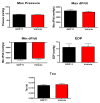GDF11 does not rescue aging-related pathological hypertrophy
- PMID: 26383970
- PMCID: PMC4636963
- DOI: 10.1161/CIRCRESAHA.115.307527
GDF11 does not rescue aging-related pathological hypertrophy
Abstract
Rationale: Growth differentiation factor 11 (GDF11) is a member of the transforming growth factor-β super family of secreted factors. A recent study showed that reduced GDF11 blood levels with aging was associated with pathological cardiac hypertrophy (PCH) and restoring GDF11 to normal levels in old mice rescued PCH.
Objective: To determine whether and by what mechanism GDF11 rescues aging dependent PCH.
Methods and results: Twenty-four-month-old C57BL/6 mice were given a daily injection of either recombinant (r) GDF11 at 0.1 mg/kg or vehicle for 28 days. rGDF11 bioactivity was confirmed in vitro. After treatment, rGDF11 levels were significantly increased, but there was no significant effect on either heart weight or body weight. Heart weight/body weight ratios of old mice were not different from 8- or 12-week-old animals, and the PCH marker atrial natriuretic peptide was not different in young versus old mice. Ejection fraction, internal ventricular dimension, and septal wall thickness were not significantly different between rGDF11 and vehicle-treated animals at baseline and remained unchanged at 1, 2, and 4 weeks of treatment. There was no difference in myocyte cross-sectional area rGDF11 versus vehicle-treated old animals. In vitro studies using phenylephrine-treated neonatal rat ventricular myocytes, to explore the putative antihypertrophic effects of GDF11, showed that GDF11 did not reduce neonatal rat ventricular myocytes hypertrophy, but instead induced hypertrophy.
Conclusions: Our studies show that there is no age-related PCH in disease-free 24-month-old C57BL/6 mice and that restoring GDF11 in old mice has no effect on cardiac structure or function.
Keywords: aging; body weight; cardiac function tests; growth differentiation factors; transforming growth factor beta.
© 2015 American Heart Association, Inc.
Figures




Comment in
-
The elusive philosopher's stone in young blood.Circ Res. 2015 Nov 6;117(11):906-8. doi: 10.1161/CIRCRESAHA.115.307645. Circ Res. 2015. PMID: 26541677 Free PMC article. No abstract available.
References
-
- Loffredo FS, Steinhauser ML, Jay SM, Gannon J, Pancoast JR, Yalamanchi P, Sinha M, Dall’Osso C, Khong D, Shadrach JL, Miller CM, Singer BS, Stewart A, Psychogios N, Gerszten RE, Hartigan AJ, Kim MJ, Serwold T, Wagers AJ, Lee RT. Growth differentiation factor 11 is a circulating factor that reverses age-related cardiac hypertrophy. Cell. 2013;153:828–39. - PMC - PubMed
-
- Ohsawa Y, Okada T, Nishimatsu S, Ishizaki M, Suga T, Fujino M, Murakami T, Uchino M, Tsuchida K, Noji S, Hinohara A, Shimizu T, Shimizu K, Sunada Y. An inhibitor of transforming growth factor beta type I receptor ameliorates muscle atrophy in a mouse model of caveolin 3-deficient muscular dystrophy. Lab Invest. 2012;92:1100–14. - PubMed
-
- Kollias HD, McDermott JC. Transforming growth factor-beta and myostatin signaling in skeletal muscle. J Appl Physiol (1985) 2008;104:579–87. - PubMed
Publication types
MeSH terms
Substances
Grants and funding
LinkOut - more resources
Full Text Sources
Other Literature Sources
Medical

